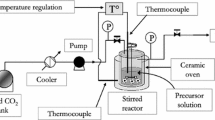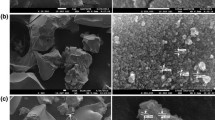Abstract
Titania powders were synthesized by thermal hydrolysis of titanium tetrachloride in a mixed solvent was studied. The dielectric constant was tuned by regulating the acetone/water volume ratio (R/H ratio) and temperature of the solvent. Hydroxypropyl cellulose (HPC) was used as a steric dispersant. The synthesis were carried out at R/H ratios of 0–4, temperatures of 70–90°C, TiCl4 concentrations of 0.05–0.2 M, HPC concentrations of 0–5 × 10−3 g/cm3, and synthesis times of 15–60 min. The TiO2 particles obtained at an R/H ratio of 0, i.e., pure water system, were fine and agglomerated. In contrast, the TiO2 particles prepared at an R/H ratio of 3 were uniform and spherical. The TiO2 particle size increased with increasing TiCl4 concentration. The synthesis temperature did not influence the particle size, but greatly influenced the morphologyof the TiO2. Adding HPC to the solution yielded more uniform and spherical particles. In addition, the synthesis time should be longer than 30 min to obtain the most uniform and spherical particles. The dielectric constant of the acetone-water mixed solvent at 28 gave the most uniform and spherical TiO2 particles. The powders prepared at the condition of 0.1 M TiCl4, R/H ratio of 3, HPC concentration of 0.001 g/cm3, temperature of 70°C, and synthesis time of 1 h exhibited the most uniform and spherical morphology. The as-synthesized powder was anatase and retained the phase below 400°C. It transformed to the rutile phase after calcination at 700°C.
Similar content being viewed by others
References
T. Ogihara, N. Mizutani, and M. Koto, Ceram. Int. 13, 35 (1987).
P. Gherardi and E. Matijevic, Colloids Surf. 32, 257 (1988).
C. Sanchez, J. Livage, M. Henry, and F. Babonneau, J. Non-Cryst. Solids 100, 65 (1988).
Y.T. Moon, D.K. Kim, and C.H. Kim, J. Am. Ceram. Soc. 78(4), 1103 (1995).
Y.T. Moon, H.K. Park, D.K. Kim, I.S. Seog, and C.H. Kim, J. Am. Ceram. Soc. 78(10), 2690 (1995).
H.K. Park, Y.T. Moon, D.K. Kim, and C.H. Kim, J. Am. Ceram. Soc. 79(10), 2727 (1996).
M.Z.-C. Hu, V. Kurian, E. A. Payzant, and C. J. Rawn, Powder Technol. 110, 2 (2000).
M.Z.-C. Hu, G.A. Miller, E.A. Payzant, and C.J. Rawn, J. Mater. Sci. 35, 2927 (2000).
F. Franks, Water-A Comprehensive Treatise (Plenum Press, New York, 1973) vol. 2, p. 405.
L. Meites, Handbook of Analytical Chemistry (McGraw-Hill Press, New York, 1982), p. 1.
I.S. Seog and C.H. Kim, J. Mater. Sci. 28, 3277 (1993).
R.J. Hunter, Foundation of Colloid Science (Clarendon Press, Oxford, UK, 1987) vol. 1, p. 443.
J.-L. Look and C.F. Zukoski, J. Colloid Interface Sci. 153(2), 469 (1992).
J.-L. Look and C.F. Zukoski, J. Am. Ceram. Soc. 78(1), 21 (1995).
J.H. Jean and T.A. Ring, Colloids and Surfaces 29, 273 (1988).
Author information
Authors and Affiliations
Rights and permissions
About this article
Cite this article
Chen, KY., Chen, YW. Synthesis of Spherical Titanium Dioxide Particles by Homogeneous Precipitation in Acetone Solution. Journal of Sol-Gel Science and Technology 27, 111–117 (2003). https://doi.org/10.1023/A:1023738215053
Issue Date:
DOI: https://doi.org/10.1023/A:1023738215053




